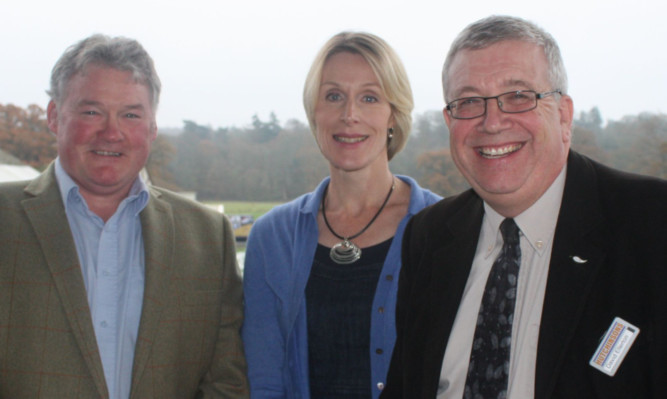There can be little doubt that Scottish combinable crops are stuck on a yield plateau, and have been for at least the last 15 years.
Andrew Gilchrist, managing director of Scottish Agronomy, told delegates to a Perth conference organised by advisory company Hutchinsons that winter wheat had only improved by 0.02 tonnes per hectare over the period.
This was in stark contrast to the dramatic gains made through the 1980s and early 1990s.
“Yields are a complex function of weather, variety choice and agronomy.
“Plant breeders claim genetic potential is still increasing so what’s happening?” he asked.
Part of the answer came from the increase in disease pressure, much of it related to warmer, wetter weather.
Larger equipment and the same wet weather was also responsible for soil damage, some of which was massive.
“We have the power available to force seedbeds but it is not the way to achieve decent yields,” he added.
At the same time, more emphasis was being paid to achieving outright yield in new varieties without sufficient attention to disease resistance.
“Most varieties are rated five or six out of 10 for disease resistance, but in field conditions we are seeing results more akin to a score of two or three. This means we are struggling to keep control of disease.
“At the same time there is no new conventional fungicide chemistry on the near horizon, and the loss of key azole chemistry is a real possibility thanks to EU legislation,” said Mr Gilchrist.
He also suggested that the 40 varieties on the HGCA Recommended List represented double the number necessary.
Looking back on the list for 1994, stalwarts such as Riband and Consort were achieving nearly 11 tonnes per hectare (t/ha), which compared favourably with modern varieties.
Indeed in Scottish Agronomy trials this year Claire, first listed in 1999, achieved very similar yields to new varieties Leeds and Viscount. Leeds, however, was a success because it had good resistance to ear disease.
Mr Gilchrist also suggested growers should be using high historical yield data from their farms to support applications to be allowed to use higher doses of nitrogen fertiliser than were allowed under the current ‘N Max’ rules.
“Applying 180-200kg of nitrogen is just not enough,” he said.
Oilseed rape yields were increasing at a more noticeable rate than those for wheat, but were held back by a combination of clubroot, light leafspot and lack of control over crop density.
Some 50% of Scottish soils were infected by club root. Although varietal resistance helped, there was a limited choice.
Unfortunately, club root varieties also carried an inherent yield penalty and new varieties were at least three years away.
Mr Gilchrist also suggested that growers might be wasting money by applying light leafspot fungicides in the autumn. The peak of infection was now more commonly seen in January or February, by which time autumn fungicides had “run out of steam”.
That was a problem because spraying in these winter months was a doubtful proposition.
He said greater understanding and better forecasting is required for light leaf spot.
Achieving optimal plant density by sowing only 30 seeds per square metre was often thwarted by the appearance of groundkeeper rape, which could easily double the population.
Using a ‘Clearfield’ variety such as DK Imagis might be the answer.
This variety had been bred to have tolerance to the herbicide Imazamox unlike the groundkeepers, which would not survive.
Dr Fiona Burnett of SRUC’s crop protection team pointed to the warm and wet winter weather which had challenged this year’s winter wheat crop.
There had been no catastrophic crop failures, but there was a continuation of the sharp decline in fungicide efficacy.
Full-label rates of active ingredients such a prothioconazole were far less effective than they had been a decade ago, and half-label rates might give as little as 10% control of septoria.
She felt that robust rates applied earlier in the season were more appropriate than trying to insert an extra spray into the programme.
Indeed, doing so might simply add to the resistance to azole chemistry.
Meanwhile, Dr David Ellerton, technical development director of conference host Hutchinsons, thought the yield plateau effect could be broken but doubted if it would be possible to beat New Zealand farmer Mike Solari’s record wheat yield of 15.7 tonnes per hectare.
Scotland’s arable areas generally had good summer rainfall and good soils but the country could never match New Zealand for solar radiation.
Mr Solari was also using around 500kg per hectare of nitrogen, which would not be allowable or practicable in Scotland.
However, Scottish growers were able to challenge on percentage of potential yield achieved.
Mr Solari’s theoretical potential yield was some 25.7t/ha, whereas in Scotland the theoretical maximum was between 18 and 21 t/ha.
Much depended on retaining green leaf on the crop, with every day of full flag leaf efficiency adding 0.15t/ha to yield.
